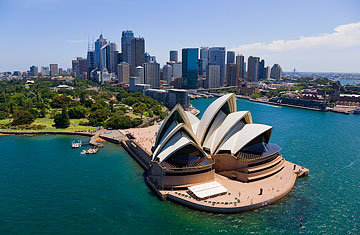
The Sydney Opera House draws millions of visitors annually, but music insiders have been grumbling about the building's acoustics for years
According to legend, when Danish architect Jorn Utzon entered a 1957 competition to design an opera house in Sydney, his sail-like sketches did not make the cut. Eero Saarinen, a Finnish-born architect on the judging panel, found his revolutionary designs in the scrap pile, fished them out and told the jury he'd found their winner. Today the Sydney Opera House is Australia's most famous building, a UNESCO World Heritage site and one of the world's busiest performing-arts centers, attracting some 4.5 million visitors a year. There's just one glitch: it looks much better than it sounds.
Music insiders have been grumbling about the building for years. Edo de Waart, the former chief conductor of the Sydney Symphony Orchestra, once threatened to boycott the building because of the bad acoustics. Matt Ockenden, an Australian bassoonist, has likened listening to a performance in the Concert Hall to watching it on a 1980s-era television.
A study released this summer confirmed their doubts. A survey of musicians, critics and audience members published in August by Limelight, an Australian music magazine, rated the Sydney Opera House's Opera Theatre as having the worst acoustics out of 20 major venues. The building's Concert Hall also scored poorly, earning a dismal 18th place.
Richard Evans, the chief executive of the Sydney Opera House, wasn't surprised by the results: "We all know about the issues with the Opera House." There have been some acoustic upgrades, he said, but the space is not as "terrific" as it could be. The Opera Theatre is not sufficient in size to produce a good acoustic for opera performances. In the Concert Hall, sawtooth wall panels need to be flattened "so the sound doesn't bounce around," Evans said. The hall also needs an acoustic ceiling over the stage platform, but there are technical difficulties with suspending something so heavy from the roof — not to mention the architectural heritage issues of changing the interior of an icon so radically.
The building's acoustic quirks date back to 1967, when New South Wales' Premier Robert Askin decided that the smaller sail, which was supposed to be a theater, should house the opera, and the larger sail, which was to house the opera, should be a concert hall. (At the time, symphonies drew in more crowds than operas did.) As a result, today's Concert Hall has 1,000 seats too many, while the Opera Theatre has a famously tiny pit.
The small pit makes it difficult for musicians to hear one another. "Where I sit as a bassoon player, I can't hear the basses and I can never hear the back of the viola sections," says Ockenden, who is associate principal bassoon at the Australian Opera and Ballet Orchestra. Over the years, the pit has been extended back into the stage. "The more it was extended, the more problems it created," said Fergus Fricke, an honorary associate professor of architecture at the University of Sydney who has done some consulting work for the Sydney Opera House. It created more space, but there was little headroom and the sound that came out from under the stage was far from ideal.
The Concert Hall, meanwhile, is too big and the sound gets lost in the 25-m-high ceiling. Acoustic upgrades in 1973 and 2009 have helped some, but the sound isn't full enough for many music lovers. "In the Concert Hall, you just want to turn the volume knob up, especially when you're sitting at the back," says Limelight editor Francis Merson.
The building can be upgraded — for a price. In March 2009, in a meeting with the Daily Telegraph, Nathan Rees, premier of New South Wales at that time, made headlines by saying that $1 billion should be invested into restoring the building and improving the acoustics. Then Prime Minister Kevin Rudd responded by saying that the project was not a government priority. Evans is now hoping to secure assistance from the state government in time for the building's 40th birthday, in 2013.
For now, performers work around the problem. "It's not the biggest pit in the world, but we make it work," says Lyndon Terracini, artistic director of Opera Australia. Next year, when Erich Wolfgang Korngold's Die tote Stadt hits the stage, the 83-piece orchestra will play in an adjacent studio, not the cramped pit, and the music will be broadcast to the audience using state-of-the-art surround sound. "It's become almost fashionable to criticize the Sydney Opera House, but it's really not that bad," he says. "Ultimately, the problem with the Opera House is that it's one of the greatest buildings in the world. There is no way that its interior can live up to that."
